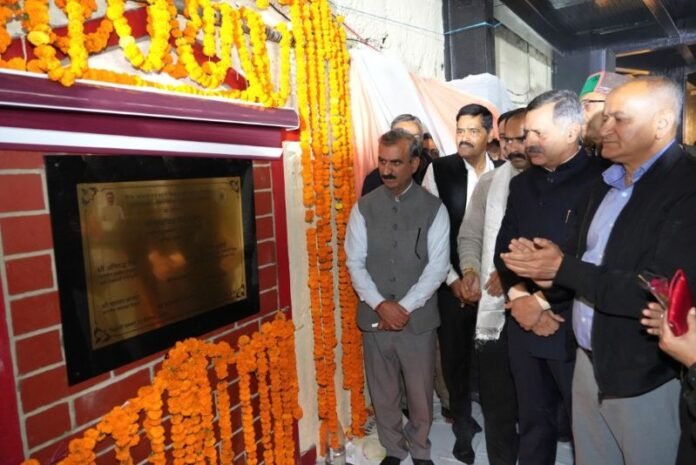In the mountainous Indian state of Himachal Pradesh, a quiet revolution is underway—rooted not in protest but in a steady assertion of long-denied rights. At its core is a question of natural justice: Should a resource-rich state continue to give without getting its fair share in return?
Standing before a newly constructed public parking facility in New Shimla—an unassuming backdrop for a weighty subject—Chief Minister Thakur Sukhvinder Singh Sukhu invoked a cause often overlooked in India’s fast-paced urban narrative: the rightful claim of Himachal Pradesh over its own water.
“Water is our most precious natural asset,” he said. “Yet, what have we received in return for what we give?” It was a strikingly direct appeal in a country where resource-sharing between states is often cloaked in bureaucratic vagueness or lost in inter-state disputes. The electricity generated from Himachal’s rivers—12,000 megawatts worth—powers cities far beyond its borders, but the people of Himachal, he argues, have seen little benefit. “The Sutlej Jal Vidyut Nigam Limited (SJVNL) is now a ₹6,700 crore company. But how much of that wealth has flowed back to us?”
The statement was as much about economics as it was about dignity—a demand for recognition, not charity. His remarks also tapped into a broader discourse on India’s internal power dynamics. While Punjab and Haryana clash legally and politically over water rights, Himachal remains the quiet source—its rivers fueling debates downstream while its own needs go under-addressed.
This imbalance is especially poignant in a state where livelihoods are deeply tied to the land and its resources. Known for its apple orchards, terraced fields, and snow-fed streams, Himachal Pradesh is a landscape shaped by and dependent on nature. Yet, the economic structure does not always favor those at the source.
Sukhu’s comments came during the inauguration of an ₹18 crore three-storey parking facility—an essential upgrade in a city whose topography makes space a luxury. More than just infrastructure, it symbolized a leadership style grounded in lived experience. “My sister lives here. I spent my childhood in this locality,” the Chief Minister recalled, bridging policy with personal memory. “Where Sector 5 stands today, there used to be walking trails. My political journey began here.” The sentiment was as telling as the speech—a grassroots politician talking not at people, but with them.
What followed was an introspective appraisal of the state’s financial inheritance. When the current government assumed power, Himachal was shackled with ₹75,000 crore in debt and ₹10,000 crore in unpaid liabilities to state employees. Yet, the administration claims to have turned a corner—adding ₹2,500 crore in revenue through transparent governance and without a single corruption charge in its two and a half years. In a country where political leadership is often marred by scandal, that declaration—if sustained—could mark a crucial differentiator.
Sukhu’s leadership has increasingly leaned toward reform that centers the everyday citizen. Minimum support prices are now in place for milk, maize, and wheat grown using natural farming methods—part of a larger push to revive sustainable agriculture. Perhaps more significantly, the state has reinstated the Old Pension Scheme for over 1.36 lakh government employees—something neighboring Punjab has yet to implement.
Infrastructure investments too are gaining pace. A ₹250 crore multi-purpose government complex is being planned in Vikasnagar, poised to house essential public services under one roof. A community center, a new primary health facility, and a modern library are also in the pipeline for New Shimla—demonstrating a broader vision of civic well-being.
This flurry of projects, however, is not without deeper political subtext. Himachal Pradesh, nestled in the Himalayas, often plays a peripheral role in national debates—overshadowed by the political heft of larger states. But Sukhu’s administration appears determined to rewrite that script. His government’s focus on water rights, employee welfare, and decentralized infrastructure suggests an emerging political identity—one that combines environmental stewardship with developmental pragmatism.
In many ways, the state’s priorities mirror wider global anxieties. Questions of resource ownership, sustainable farming, and rural resilience are no longer local issues—they are international imperatives. Himachal’s demand for fair compensation for its natural assets, therefore, finds resonance in broader conversations about equity and ecological justice.
As Rural Development Minister Anirudh Singh remarked, the Chief Minister’s closeness to the region’s challenges is not performative but practical. The administration’s willingness to confront legacy problems head-on—despite financial constraints and inclement political weather—has fostered a quiet credibility among citizens.
The unfolding story in Himachal Pradesh is not just about dams, debts, or development—it’s about reclaiming agency. It’s about a hill state that refuses to remain invisible in its own narrative, a leadership that blends memory with mandate, and a people ready to stake their claim—not as victims of geography, but as rightful participants in the national promise.
Disclaimer: This article is based on publicly available government statements and verified media reports.
#HimachalWaterRights #IndianPolitics #SustainableDevelopment #GreenState #CMLeadership




